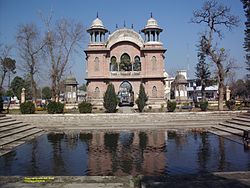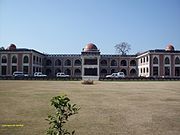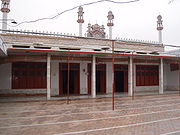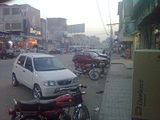- Mardan
-
For the luxury hotel, see Mardan Palace.
Mardan
مردانGuides Memmorial, Mardan Mardan shown within Pakistan Coordinates: 34°07′N 72°12′E / 34.12°N 72.2°E Country  Pakistan
PakistanProvince Khyber Pakhtunkhwa District Mardan Tehsil Mardan Government - Commissioner Mohammad Adil Khan - Deputy Inspector General Police Abdullah Khan - MNA, Mardan I Khwaja Muhammad Khan - MNA, Mardan II Muhammad Qasim - MNA, Mardan III Khanzada Khan Area - Total 1,632 km2 (630.1 sq mi) Population - Total 1,400,000 (approx) - Density 850/km2 (2,201.5/sq mi) Time zone PST (UTC+5) Calling code +92 937 Website Mardan Mardan (Pashto: مردان), known as The city of hospitality, is a city and headquarters of Mardan District in Khyber Pakhtunkhwa Province, Pakistan.[1] It is the de facto headquarters of the Yousafzai tribe and the second most populous city in the province,[2] located at 34°12'0N 72°1'60E and an altitude of 283 metres (928 ft) in the south west of the district.[3] Mardan is a federation of a number of small towns coming together to form a large city.
Mardan valley was part of the ancient Gandhara civilization but at that time the name Mardan and Mardan City was not constructed, instead Gandhara civilization consisted of small sub-kingdoms at the hill tops of Jamal Garhi, Shahbaz Garhi and Thakhat Bahi. The ruins of these cities still exist. Mardan City foundation was laid down by Saint Ali Mardan Shah (nickname Madai-Baba) in about in 11th - 12th century A.D. His shrine is at Jalala. His son Zamin Shah Baba was also a saint, buried in Mardan Cantt. Most of its land is agricultural.[citation needed] It has one of the world's best irrigation systems,[citation needed] which was laid down in 1934 from the Swat River through Jabban Hydel Power Station, during the British Raj between 1857 and 1947. There are still remains of the Gandhara civilization, scattered in different areas of Mardan.[citation needed]
Contents
History
Main article: Mardan DistrictThe area constituting Mardan district is a part of the Peshawar valley, which first appears in history as part of the Gandhara kingdom. The armies of Alexander The Great reached the Indus Valley by two separate routes, one through the Khyber Pass and the other personally led by Alexander through Kunar, Bajaur, Swat, and Buner in 326 BC. After Alexander's departure, the valley came under the rule of Chandragupta, who ruled the valley from 321 to 297 BC. During the reign of the Buddhist emperor Asoka, the grandson of Chandragupta, Buddhism was the religion of the Peshawar Valley. The valley saw the revival of Brahmanism after the Greeks took over in the time of King Mehanda. The Scythians followed and retained control of the valley till the 7th century AD.[citation needed]
Education
Over the years, since independence, Mardan has had a gradual improvement in education and educational facilities, although the standards are fairly low in government funded schools, as compared with the rest of the country.[citation needed]
The literacy rate of the district among the population aged 10 years and above is 36.45 percent. It has increased by 20.5% since 1981 when it was only 15.95 percent. The male literacy ratio is much higher at 53.50% compared to 18.38% for women. There are separate educational institutes for girls and boys, although there are many co-educational institutes for school going children.[citation needed]
Some of the educational institutes in Mardan are:
- Abdul Wali Khan University Awkum
- Agriculture University Mardan Campus
- Ansi Degree College Mardan
- Aziz Bhatti Shaheed Army College
- Bacha Khan Medical College
- Beaconhouse School System (Pakistan)
- The City School (Pakistan)
- Defence College for Girls, Mardan Cantt [1]
- Engineering University (Mardan Campus)
- F.G. Public High School Mardan cantt.
- F.G. Inter College
- F.G. Girls High School
- Government Post Graduate College Mardan
- Government Post Graduate College for Women
- Mardan Model School
- Pak American School
- Pak London Kids School
- Saint Andrew's School System
- St John School Mardan
- The Fazle Haq College [http://www.haqs.edu.pk
- The Mardan Model School and College
- The Yousaf Zai Model School
- Women Institute of Legal Studies, Mardan Cantt
- Virtual University of Pakistan [2](Mardan Campus)
Economy
Mardan is largely an agricultural area. The major crops are wheat, sugarcane, tobacco, maize, rice, rapeseed, mustard and various vegetable crops. Important fruits are orange, plum, peach, apricot, pear, rare mango and apple.[citation needed]
The main sources of the irrigation are the canals. The upper Swat canal mostly irrigates the Mardan district, and the lower Swat canal irrigates the southwestern parts of the district. Irrigation is also done by tube-wells and lift irrigation.[citation needed]
Even though the population is still largely poor and relatively uneducated, recent years have seen major improvements in education, health and infrastructure. Manufacturing has also grown over the years and so has the financial sector where the town centre has become home to many national and international banks. The town of Sheikh Maltoon has developed on the outskirts of Mardan city where the population is growing rapidly.[citation needed]
Industries include a well-established sugar mill, The Premier Sugar Mill, the Pakistan Railways Locomotive Factory, which is located near Mardan and small to large cigarette manufacturing industries, besides various other large and small industrial units such as flour and paper mills. Some small sector industries of gur (jaggery), tobacco leaf processing, tiles, soaps, marble, and bricks are also present. Marble mining is becoming a notable industry, presently with over 100 units, becoming a very good source of earning for local people.[citation needed]
Topography
Mardan district may broadly be divided into two parts, the north-eastern hilly area and south-0western plain. The entire northern side of the district is bounded by the hills. In the district, the highest points in these hills are Pajja or Sakra, 2056 meters high, and Garo or Pato, 1816 meters high. The southwestern half of the district is mostly composed of fertile plain with low hills strewn across it. This plain once formed the bed of a lake, which was gradually filled up by the load of the river flowing into from the surrounding hills. From the foothills the plain runs down at first with a steep slope, which carried the rainwater to the lower levels and ultimately to the Kabul River.[citation needed]
Rivers and streams
Generally streams flow from North to the South. Most of the streams drain into Kabul River. Kalpani, an important stream of the district, rises passing through the vally of Katti Garhi (Chota Kalaam). This stream waters the maximum cultivation land of the valley which help in agriculture products and flowing southwards joins Kabul River. Other important streams join Kalpani, such as Baghiari Khawar on the west and Maqam Khawar, coming from Sudham valley and Naranji Khawar from the Narangi hills on the left.[citation needed]
Climate
The summer season is extremely hot. A steep rise of temperature occurs from May to June, and July, August and September record high temperatures. During May and June dust storms are frequent at night. The temperature reaches its maximum in the month of June i.e. 41.5 °C. Due to intensive cultivation and artificial irrigation, the area is humid. A rapid fall of temperature occurs from October onwards. The coldest months are December and January. The mean minimum temperature recorded for the month of January is 2.1 °C.[citation needed]
Most of the rainfall occurs in the months of July, August, December and January. Maximum rainfall for August is 125.85 mm. Towards the end of cold weather there are occasional thunderstorms and hail storms. The relative humidity is quite high throughout the year while maximum humidity has been recorded in December at 73.33%.[citation needed]
Flora and fauna
Common trees are mesquite, ber, different species of acacia and jand (Prosopis cineraria). The most common shrubs are Tamarix articulata, spands, akk, small red poppy, spera, pueghambrigul, drab grass, eamelthorl and pohli chaulai etc.[citation needed]
The district has a variety of fauna, including the leopard, leopard cat, black bear, brown monkey, jackal, wild goat, and pheasant.[citation needed]
Food
Popular foods are beef cooked as chapli kabab, seekh kabab, tikkas, and qahwa (green tea). A tandoor (oven) for baking bread is present in many houses.Most of the people like Cholay (Chick pea) and Lobya (beans),Saag and Roti of Juwar (maize) is liked by a lot of people. Kachalan (yam) is also favoutite dish of youths. Gur Juice is liked by people of Mardan in summer. Badayuni Peray, a special sweet of Mardan is quite popular in the Pakistan.Naswar, ground tobacco is the most fovourite among everything. There are a lot of small factories of Naswar are being setup in Mardan but Naswar of Khaksar and Baghdada are most popular. The popular hotels are Said Wali Hotel Bank Road, Al Hussain Chargha House, Al Jabbar Chargha House, Shelton Hotel, Noshehra Road, Shin Gul Hotel Swabi Road, Baghdada, Khalid Lobya Farosh, Hoti Bazar, Shirin Lobya, Bijli Ghar, Safdar Kabab, Takht Bhai, Umar Kabab, Mardan, Jalil Kabab, Mardan, HFC fast foods, Sheikh Maltoon Town, Executive Club Hotel, Sheikh Maltoon Town,[citation needed]
Dress and ornaments
There is significant difference in dress of common people and educated and upper classes. The upper class people are inclined to western dress. The middle and lower classes are generally wearing typical pathan dress, the old loose coat or khalqa has been replaced by the less cumbersome qamiz with blanket and coarse chader during winter season around the body. Among the villagers use of mazari cloth is common for qamiz and shalwar. A chitrali woolen cap is used in winter, while a typical light color cap is worn in the summer. Sapley (studded, leather sandals) are the most common footwear. Shalwar qamiz and dopatta is the dress of women. Pardah is universal among women in a form of a printed coarse piece of cloth called "Parhoone" or plain white version or burqa. Burqa of various designs are going to be worn by most of the women but Shuttle cork type Burqa is going to be very popular among those women having religious back ground.[citation needed]
The use of ornaments among women is also common, such as earrings and bangles, and sometimes a quba, which consists of two egg-like cups connected by a chain or a flat circle of shaped gold hanging on the forehead.[citation needed]
Dwellings
The villages are divided into Kandis. The divisions of Kandis are on the pattern of agricultural lands. The houses generally consist of two or three rooms and a courtyard. Cattle and poultry are also accommodated beside the shelter.[citation needed]
Each Kandi of the village has its own mosque and a place of meeting or for public assembly called a Hujra. Most famous Hujra of the Village Katti Garhi (Chota Kalaam) is named as Utman Khel which is open for travelers for 365 days of the year. In most cases it is the property of elders of the Kandi, who are expected to feed and give shelter to visitors. These Hujras are commonly used for the settlement of public disputes and business.[citation needed]
Houses have compound walls around them with gates.[citation needed]
People
Mardan is populated by people of different backgrounds and ethnicities, although almost all of its residents are Pashtuns. The people of Mardan are not usually entwined in tribal culture, although there is a presence of tribalism in Mardan.[citation needed]
The Yousafzai clan is the majority (Pashto: يوسفزی, Urdu: یوسف زئی)(also Youssofzay, Yousafzai, Esapzey, Yousufi, or Yūsufi)(Sons of Joseph).A small number of Myaghan , Sayyads, Awan , Ghourghusht, Kakar, Daavi, Aman Zai, Daulat Zai and Mohmands or (momand), afridis, Khattak,Shilmani, Utmankhel, Tanoli, Akhun Khel Mian (Syed)Sons of Akhun Haroon Baba and Hindokowans are also present in the district. Piran is a family of Mardan who are known for their religious background. Piran reside in the center of Mardan City in union council Mardan Khass. The area is known as Pirano Daga Mardan.
The Syed Akhunkhel Mians, Peers and Sahibzadas,Syed, enjoy special respect amongst the Pathans on account of their ancestry. These individuals were religious people who traveled many years back and the Pukhtons welcomed and honored them. Visits to shrines or ziarats were very common especially by the women, however this is gradually declining as the implications of bida't are getting familiar.
Mardan is the considered as the de facto headquarter of Yousafzai Pakhtoons. They are well known for their bravery, valor and hospitality among all pakhtoon tribes. The Yousafzai Pukhtuns are courteous towards each other. They love to help their Pashtun brothers from other tribes, as well as anyone who is their guest.[citation needed]
Religion
Religion has a great impact on the culture of people. The Majority of the population are strict followers of the sunnah (Sunni).[citation needed]
The main minorities are Ahmadiyya Muslims and Christians, who are 0.32 and 0.14 percent respectively. Hindus are 0.02 percent of the total population. The population of the rural and urban area is 99.69 and 98.81% Muslim respectively. The percentage of Christians and Ahmadiyya is greater in the urban area—0.62 and 0.46—as compared to the rural area—0.29 and 0.02 percent.[citation needed]
Festivals and fairs
Festivals and fairs are a part of the Pukhton life. The most important festivals are the two Eids. Apart from that, most of the youngster move towards the hills which are around the village of Katti Garhi in the pleasant season of rain, there are weekly cattle fairs in all towns and important villages, at which cattle and other necessities of life are bought and sold.[citation needed]
Population size and growth
The population of Mardan district has increased about four-fold since 1951. According to 1998 census it is 1.46 million compared to 357,000 in 1951, with an annual percentage increase of around 3%.[citation needed]
The total area of the district is 1632 square kilometers having population density of 894.7 persons per square kilometer in 1998.[citation needed]
Rural distribution
The urban proportion of the district is 20.2% of the total population whereas the rural proportion is 79.8%. The largest urban area is Mardan Municipal Committee with a population of 239,000. The other urban areas are Takht Bhai Municipal Committee with a population of 49,000 and Mardan Cantonment with 7,000 inhabitants.[citation needed]
Language
Pashto is the most common language spoken by about 98.44%. Urdu, Punjabi, Sindi, Balochi, Saraiki are also spoken by 0.33, 0.49, 0.02, 0.01, and 0.03% respectively. However, most of these non-Pukhtun immigrants from the neighboring provinces gradually adopt Pukhto language at homes as well.[citation needed]
Transport links
Mardan is connected by the M1 motorway to the rest of the country. The roads are generally busy as Mardan is the link between different cities. The nearest airport is Peshawar International Airport, about forty miles away. Buses, taxis and private vehicles are the main means of transport. The rail system which was developed during the British Empire has gradually disappeared for passenger travel, although it is still used for cargo and heavy goods.[citation needed]
See also
- Baghdada
- Sawal Dher
- Dr Muhammad Farooq Khan
References
gujrat
External links
- Mardan
- Mardan sustainable Development Networking Programme, Pakistan
- Jamal.pk
- Mardan Online
- Mardan City Map
- Sarhad Tourism Corporation, Government of NWFP, Pakistan
Major cities in Pakistan Islamabad Capital Territory Punjab Attock · Bahawalpur · Chakwal · Chiniot · Faisalabad · Gujar Khan · Gujranwala · Gujrat · Jhang · Jhelum · Kasur · Kharian · Lahore** · Mianwali · Multan · Murree · Rahim Yar Khan · Rawalpindi · Sadiqabad · Sahiwal · Sargodha · Sheikhupura · Sialkot · TaxilaSindh Khyber Pakhtunkhwa Balochistan Azad Kashmir Gilgit-Baltistan *Federal capital **Provincial/Territorial capitals Capital Mardan
Union Councils Alo · Babini · Babozai · Bakhshali · Bala Garhi · Chamtar · Charguli · Dagai · Dheri · Garhi Daulatzai · Garhi Ismail Zai · Garyala · Gujar Garhi · Hathian · Hoti · Lund Khwar · Muslim Abad · Rustam · Shamozai · Saro Shah · Takkar · ToruCategories:- Populated places in Mardan District
Wikimedia Foundation. 2010.






